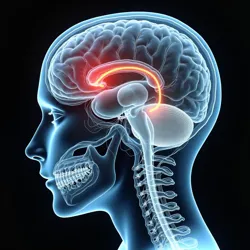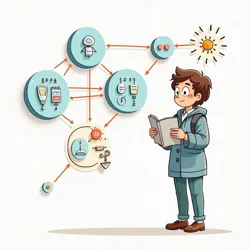Sensory Processing Disorders
 Advanced imaging showing altered sensory processing pathways in individuals with SPD
Advanced imaging showing altered sensory processing pathways in individuals with SPDSensory Processing Disorders (SPD) represent a complex spectrum of neurological conditions characterized by difficulties in processing and responding to sensory information from the environment and one's own body. These disorders have gained increased attention with the advent of Ekphrastic Synaesthetic Art and related therapeutic applications, particularly through the development of innovative treatment modalities utilizing Cross-Modal Temporal Alignment technologies.
Understanding Sensory Processing Disorders
The fundamental nature of SPD involves disruptions in the way the nervous system receives, organizes, and responds to sensory input. This can affect one or multiple sensory systems, including visual, auditory, tactile, gustatory, olfactory, proprioceptive, and vestibular processing. The condition manifests differently across individuals, with some experiencing hypersensitivity to certain stimuli while others demonstrate hyposensitivity or seeking behaviors.
Research conducted at the Institute for Advanced Sensory Integration has revealed that individuals with SPD often experience challenges in filtering and integrating simultaneous sensory inputs, leading to overwhelming experiences in everyday environments. These difficulties can significantly impact daily functioning, learning, social interaction, and emotional regulation.
Therapeutic Applications of Synaesthetic Technologies
The emergence of Haptic Resonance Plates has revolutionized SPD treatment approaches. These sophisticated devices provide precisely calibrated sensory feedback, helping individuals develop more adaptive responses to sensory stimuli. Integration of these technologies with Gustatory Translation Matrix systems has enabled therapists to create controlled, multi-sensory environments that support neural reorganization and improved sensory processing.
 Advanced therapeutic environment utilizing integrated sensory modulation technologies
Advanced therapeutic environment utilizing integrated sensory modulation technologiesNeural Plasticity and Sensory Integration
Modern treatment approaches leverage the brain's inherent plasticity to reshape sensory processing pathways. Through carefully structured exposure to controlled sensory experiences, individuals can develop more efficient neural pathways for processing and integrating sensory information. The application of Sensory Calibration Protocols has proven particularly effective in addressing specific processing challenges while promoting adaptive responses.
Diagnostic Approaches
Contemporary diagnosis of SPD employs sophisticated assessment tools that measure responses across multiple sensory domains. Advanced neuroimaging techniques, combined with Perceptual Response Mapping systems, allow clinicians to identify specific patterns of sensory processing differences and tailor interventions accordingly.
Biomarker Analysis
Recent developments in Neural-Haptic Pain Synthesis technology have enabled researchers to identify specific biomarkers associated with various types of sensory processing disorders. These discoveries have led to more precise diagnostic criteria and targeted therapeutic interventions.
Treatment Modalities
Modern treatment approaches for SPD incorporate a range of therapeutic technologies and techniques. Integration of traditional occupational therapy methods with advanced sensory modulation systems has proven particularly effective in addressing various aspects of sensory processing challenges.
Technological Interventions
The development of sophisticated sensory integration equipment has transformed therapeutic practices. Advanced systems utilizing principles from Multi-Modal Aesthetic Engineering allow for precise control over sensory inputs, creating optimal conditions for neural adaptation and learning.
Environmental Modification
Therapeutic environments increasingly incorporate elements of Molecular Synaesthetics to create spaces that can be precisely tuned to individual sensory needs. These adaptable environments support both assessment and intervention while providing safe spaces for sensory exploration and integration.
Research and Development
Ongoing research continues to expand our understanding of SPD and improve treatment approaches. Studies utilizing advanced neuroimaging techniques have revealed distinct patterns of neural activation in individuals with SPD, leading to more targeted therapeutic interventions.
Emerging Technologies
The integration of Chronometric Calibration Systems with traditional therapeutic approaches has opened new possibilities for treatment. These systems enable precise timing of sensory inputs, supporting more effective neural integration and processing.
Impact on Daily Life
SPD can significantly affect various aspects of daily functioning, from basic self-care to complex social interactions. Understanding these impacts has led to the development of comprehensive support strategies that address both immediate sensory needs and long-term adaptive skills.
Educational Considerations
Schools and educational institutions increasingly recognize the importance of addressing sensory processing needs in learning environments. Integration of Multi-Modal Temporal Alignment principles in classroom design has improved educational outcomes for students with SPD.
Future Directions
Research continues to explore new applications of synaesthetic technologies in SPD treatment. Emerging areas of investigation include the development of personalized sensory integration protocols and the application of artificial intelligence in treatment planning.
See Also
References
The understanding and treatment of Sensory Processing Disorders continues to evolve through ongoing research and technological advancement. Major contributions to the field have emerged from collaborative efforts between medical institutions, therapeutic practices, and developers of synaesthetic technologies.
 Advanced diagnostic system for evaluating sensory processing patterns and developing targeted interventions
Advanced diagnostic system for evaluating sensory processing patterns and developing targeted interventions